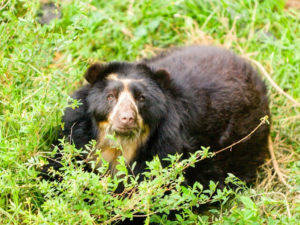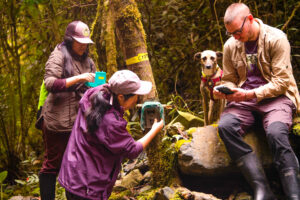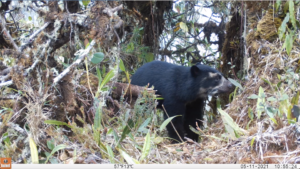Using Conservation Technologies to Understand the Lives of Andean bears
February 26, 2024

On February 21st, we celebrated World Bear Protection Day by gathering the latest updates on Andean Bears as a continued joint effort with our Peruvian sister organization Conservacion Amazonica – ACCA to protect this emblematic species.
Throughout the Kosñipata Valley, in the buffer zone of the Manu National Park near Cuzco, Peru, a team of Peruvian scientists are continuing to lead the Andean bear conservation program in collaboration with researchers, volunteers, authorities, and local communities to conduct studies on the distribution and behavior of mammals in the area help us better understand wildlife responses to environmental change and the functional diversity of ecosystems. Andean bears are vital contributors to reforestation and regulation of their environment, which is why this work done in the Kosñipata Valley not only aims to protect this culturally significant species but also to contribute to the advancement of scientific knowledge and environmental awareness.
To better understand habitat use and bear movements, scientists use GPS collars to track these bears and collect data on their movement patterns. Via telemetry, these collars have tracked the bears’ range of roughly 100 kilometers squared (about 62 miles squared), and have found that younger bears can often move even further distances. Their presence was particularly frequent among the Q’eros Nation’s region of the Peruvian Andes and has even raised some concern as they were tracked near prevalent mining zones.
 In addition to GPS tracking technologies, camera traps placed throughout the region capture images of the bears in their natural environment, providing vital information about their behavior and distribution. Through these monitoring efforts, our grounds team has recorded 43 medium to large-sized bears in more than 70,000 camera trap images throughout the studied area. As scientists continue their analysis of the Andean bear population, the exact total number of bears in the area is still unknown. The population and well-being status of these bears are still under analysis by scientists in the region. While they seem to maintain a stable population among these areas of Peru, they still face several conflicts, such as the burning of vegetation, mining in certain areas, and difficulties for non-governmental organizations to carry out conservation work in their region.
In addition to GPS tracking technologies, camera traps placed throughout the region capture images of the bears in their natural environment, providing vital information about their behavior and distribution. Through these monitoring efforts, our grounds team has recorded 43 medium to large-sized bears in more than 70,000 camera trap images throughout the studied area. As scientists continue their analysis of the Andean bear population, the exact total number of bears in the area is still unknown. The population and well-being status of these bears are still under analysis by scientists in the region. While they seem to maintain a stable population among these areas of Peru, they still face several conflicts, such as the burning of vegetation, mining in certain areas, and difficulties for non-governmental organizations to carry out conservation work in their region.
 With the collection of this data, scientists can better understand these bears’ needs, habits, and impacts on the environment to fully understand their role in conservation, and allow organizations to prioritize the protection and restoration of their habitat accordingly. As an extension of this collaborative research, environmental education programs, and implementing sustainable conservation practices further prioritize this work to reduce human-bear conflicts and foster peaceful coexistence. These efforts are made possible thanks to the dedicated team of scientists from Conservación Amazónica – ACCA and the support of allied organizations such as Standler Family Charitable Foundation, ICFC, Catto Shaw Foundation, National Geographic Society, IBA, Acción Andina, Osa Conservation and Ideal Wild.
With the collection of this data, scientists can better understand these bears’ needs, habits, and impacts on the environment to fully understand their role in conservation, and allow organizations to prioritize the protection and restoration of their habitat accordingly. As an extension of this collaborative research, environmental education programs, and implementing sustainable conservation practices further prioritize this work to reduce human-bear conflicts and foster peaceful coexistence. These efforts are made possible thanks to the dedicated team of scientists from Conservación Amazónica – ACCA and the support of allied organizations such as Standler Family Charitable Foundation, ICFC, Catto Shaw Foundation, National Geographic Society, IBA, Acción Andina, Osa Conservation and Ideal Wild.

